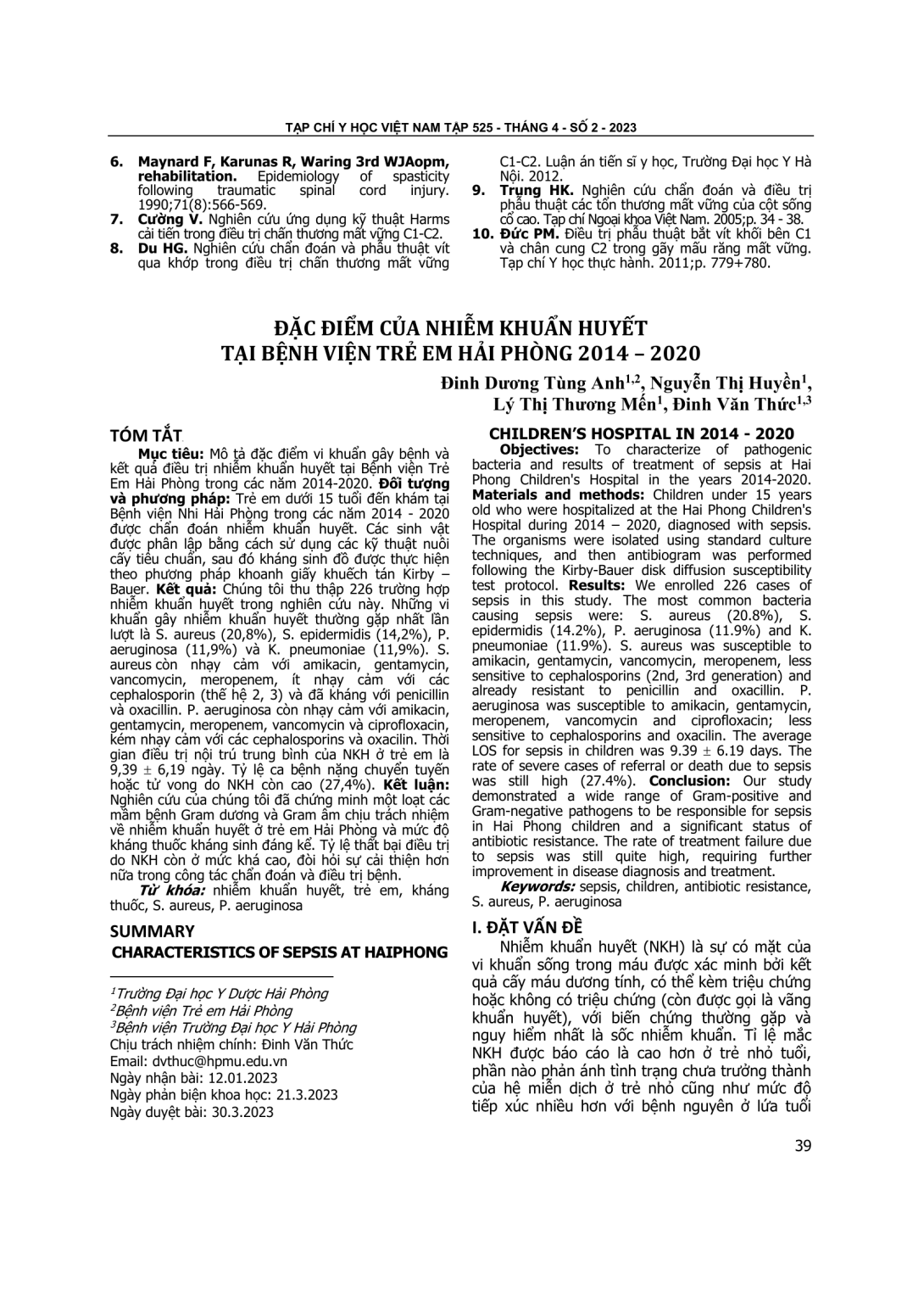
Mô tả đặc điểm vi khuẩn gây bệnh và kết quả điều trị nhiễm khuẩn huyết tại Bệnh viện Trẻ Em Hải Phòng trong các năm 2014-2020. Đối tượng và phương pháp: Trẻ em dưới 15 tuổi đến khám tại Bệnh viện Nhi Hải Phòng trong các năm 2014 - 2020 được chẩn đoán nhiễm khuẩn huyết. Các sinh vật được phân lập bằng cách sử dụng các kỹ thuật nuôi cấy tiêu chuẩn, sau đó kháng sinh đồ được thực hiện theo phương pháp khoanh giấy khuếch tán Kirby – Bauer. Kết quả: Chúng tôi thu thập 226 trường hợp nhiễm khuẩn huyết trong nghiên cứu này. Những vi khuẩn gây nhiễm khuẩn huyết thường gặp nhất lần lượt là S. aureus (20,8%), S. epidermidis (14,2%), P. aeruginosa (11,9%) và K. pneumoniae (11,9%). S. aureus còn nhạy cảm với amikacin, gentamycin, vancomycin, meropenem, ít nhạy cảm với các cephalosporin (thế hệ 2, 3) và đã kháng với penicillin và oxacillin. P. aeruginosa còn nhạy cảm với amikacin, gentamycin, meropenem, vancomycin và ciprofloxacin, kém nhạy cảm với các cephalosporins và oxacilin. Thời gian điều trị nội trú trung bình của NKH ở trẻ em là 9,39 6,19 ngày. Tỷ lệ ca bệnh nặng chuyển tuyến hoặc tử vong do NKH còn cao (27,4%). Kết luận: Nghiên cứu của chúng tôi đã chứng minh một loạt các mầm bệnh Gram dương và Gram âm chịu trách nhiệm về nhiễm khuẩn huyết ở trẻ em Hải Phòng và mức độ kháng thuốc kháng sinh đáng kể. Tỷ lệ thất bại điều trị do NKH còn ở mức khá cao, đòi hỏi sự cải thiện hơn nữa trong công tác chẩn đoán và điều trị bệnh.
To characterize of pathogenic bacteria and results of treatment of sepsis at Hai Phong Children's Hospital in the years 2014-2020. Materials and methods: Children under 15 years old who were hospitalized at the Hai Phong Children's Hospital during 2014 – 2020, diagnosed with sepsis. The organisms were isolated using standard culture techniques, and then antibiogram was performed following the Kirby-Bauer disk diffusion susceptibility test protocol. Results: We enrolled 226 cases of sepsis in this study. The most common bacteria causing sepsis were: S. aureus (20.8%), S. epidermidis (14.2%), P. aeruginosa (11.9%) and K. pneumoniae (11.9%). S. aureus was susceptible to amikacin, gentamycin, vancomycin, meropenem, less sensitive to cephalosporins (2nd, 3rd generation) and already resistant to penicillin and oxacillin. P. aeruginosa was susceptible to amikacin, gentamycin, meropenem, vancomycin and ciprofloxacin; less sensitive to cephalosporins and oxacilin. The average LOS for sepsis in children was 9.39 6.19 days. The rate of severe cases of referral or death due to sepsis was still high (27.4%). Conclusion: Our study demonstrated a wide range of Gram-positive and Gram-negative pathogens to be responsible for sepsis in Hai Phong children and a significant status of antibiotic resistance. The rate of treatment failure due to sepsis was still quite high, requiring further improvement in disease diagnosis and treatment.
- Đăng nhập để gửi ý kiến
